2011 AMC 10/12 A Discussion
Go back to the Math Jam ArchiveA discussion of problems from the AMC 10/12 A, which is administered February 8. We will cover the last 5 problems on each test, as well as requested earlier problems on the tests.
Copyright © 2025 AoPS Incorporated. This page is copyrighted material. You can view and print this page for your own use, but you cannot share the contents of this file with others.
Facilitator: Dave Patrick
DPatrick
2011-02-09 19:30:00
Welcome to the 2011 AMC 10A/12A Math Jam!
Welcome to the 2011 AMC 10A/12A Math Jam!
DPatrick
2011-02-09 19:30:10
I'm Dave Patrick, and I'll be leading our discussion tonight.
I'm Dave Patrick, and I'll be leading our discussion tonight.
DPatrick
2011-02-09 19:30:23
Before we get started I would like to take a moment to explain our virtual classroom to those who have not previously participated in a Math Jam or one of our online classes.
Before we get started I would like to take a moment to explain our virtual classroom to those who have not previously participated in a Math Jam or one of our online classes.
DPatrick
2011-02-09 19:30:36
The classroom is moderated, meaning that students can type into the classroom, but these comments will not go directly into the room. These comments go to the instructors, who may choose to share your comments with the room.
The classroom is moderated, meaning that students can type into the classroom, but these comments will not go directly into the room. These comments go to the instructors, who may choose to share your comments with the room.
DPatrick
2011-02-09 19:30:52
This helps keep the session organized and on track. This also means that only well-written comments will be dropped into the classroom, so please take time writing responses that are complete and easy to read.
This helps keep the session organized and on track. This also means that only well-written comments will be dropped into the classroom, so please take time writing responses that are complete and easy to read.
DPatrick
2011-02-09 19:31:15
There are a lot of students here! As I said, only well-written comments will be passed to the entire group. Please do not take it personally if your comments do not get posted, and please do not complain about it. This Math Jam is much larger than our typical class, so please be patient with me---there are quite a few of you here tonight!!
There are a lot of students here! As I said, only well-written comments will be passed to the entire group. Please do not take it personally if your comments do not get posted, and please do not complain about it. This Math Jam is much larger than our typical class, so please be patient with me---there are quite a few of you here tonight!!
DPatrick
2011-02-09 19:31:39
Also, we won't be going through the math quite as thoroughly as we do in our classes -- I can't teach all the necessary material for every problem as we go.
Also, we won't be going through the math quite as thoroughly as we do in our classes -- I can't teach all the necessary material for every problem as we go.
DPatrick
2011-02-09 19:31:52
Another difference between tonight and our regular online classes is that it is very unlikely that we'll be able to answer every single question you ask. We usually do in our classes, but we have a large number of students tonight! So, please go ahead and ask questions, but also please understand if we aren't able to answer them all!
Another difference between tonight and our regular online classes is that it is very unlikely that we'll be able to answer every single question you ask. We usually do in our classes, but we have a large number of students tonight! So, please go ahead and ask questions, but also please understand if we aren't able to answer them all!
DPatrick
2011-02-09 19:32:24
Please: do not ask questions during the Math Jam about administrative aspects of the contests. We do not have time to answer them all.
Please: do not ask questions during the Math Jam about administrative aspects of the contests. We do not have time to answer them all.
DPatrick
2011-02-09 19:32:47
We do have an assistant tonight who can help answer some of the questions. He is Patrick Hulin (worthawholebean). Patrick started doing math competitions in elementary school and attended National MATHCOUNTS in 2006. In 2010, he received an honorable mention on the USA Math Olympiad. He currently studies math at MIT.
We do have an assistant tonight who can help answer some of the questions. He is Patrick Hulin (worthawholebean). Patrick started doing math competitions in elementary school and attended National MATHCOUNTS in 2006. In 2010, he received an honorable mention on the USA Math Olympiad. He currently studies math at MIT.
DPatrick
2011-02-09 19:33:02
He can answer questions by whispering to you or by opening a window with you to chat 1-on-1.
He can answer questions by whispering to you or by opening a window with you to chat 1-on-1.
DPatrick
2011-02-09 19:33:28
Please also remember that the purpose of this Math Jam is to work through the solutions to AMC problems, and not to merely present the answers. "Working through the solutions" includes discussing problem-solving tactics.
Please also remember that the purpose of this Math Jam is to work through the solutions to AMC problems, and not to merely present the answers. "Working through the solutions" includes discussing problem-solving tactics.
DPatrick
2011-02-09 19:33:40
So please, when a question is posted, do not simply respond with the final answer. That's not why we're here.
So please, when a question is posted, do not simply respond with the final answer. That's not why we're here.
DPatrick
2011-02-09 19:33:50
We're going to work through the problems step-by-step.
We're going to work through the problems step-by-step.
DPatrick
2011-02-09 19:34:04
The Math Jam will proceed as follows:
We will work the last 5 problems from the AMC 10A, then the last 5 problems from the AMC 12A. After that, time permitting, I will take requests for some other problems for discussion.
The Math Jam will proceed as follows:
We will work the last 5 problems from the AMC 10A, then the last 5 problems from the AMC 12A. After that, time permitting, I will take requests for some other problems for discussion.
DPatrick
2011-02-09 19:34:24
We'll probably run for 1.5 to 2 hours.
We'll probably run for 1.5 to 2 hours.
DPatrick
2011-02-09 19:34:37
OK...let's get started with #21 from the AMC 10A:
OK...let's get started with #21 from the AMC 10A:
DPatrick
2011-02-09 19:34:45
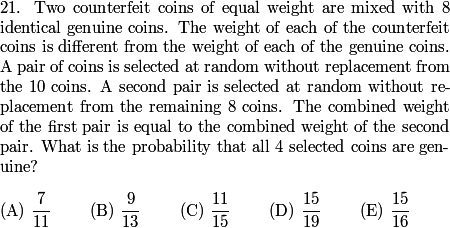

DPatrick
2011-02-09 19:34:56
Notice that I will always put the current problem at the top of the window. You can resize the area at the top by dragging the horizontal gray bar.
Notice that I will always put the current problem at the top of the window. You can resize the area at the top by dragging the horizontal gray bar.
DPatrick
2011-02-09 19:35:11
How can it occur that the two weights are equal?
How can it occur that the two weights are equal?
EricMathPath09
2011-02-09 19:35:48
There are only two possibilities- you select one couterfeit and one genuine coin both times, or you select two pairs of genuine coins.
There are only two possibilities- you select one couterfeit and one genuine coin both times, or you select two pairs of genuine coins.
Jerry1997
2011-02-09 19:35:48
1 genuine with 1 fake or two genuines on both sides
1 genuine with 1 fake or two genuines on both sides
furrykid
2011-02-09 19:35:48
all real coins, or 1 real and 1 counterfeit in each pair.
all real coins, or 1 real and 1 counterfeit in each pair.
DPatrick
2011-02-09 19:35:56
We could either have 4 genuine coins, or each pair could have 1 real and 1 fake coin.
We could either have 4 genuine coins, or each pair could have 1 real and 1 fake coin.
DPatrick
2011-02-09 19:36:06
In how many ways can we pick two pairs of genuine coins?
In how many ways can we pick two pairs of genuine coins?
BOGTRO
2011-02-09 19:36:38
8C2*6C2
8C2*6C2
christerson
2011-02-09 19:36:38
(8C2)(6C2)
(8C2)(6C2)
tekgeek
2011-02-09 19:36:38
8C2*6C2
8C2*6C2
Maxima
2011-02-09 19:36:38
8C2 * 6C2.
8C2 * 6C2.
DPatrick
2011-02-09 19:36:45
There are 8 genuine coins, so we can select C(8,2) = (8*7)/2 = 28 pairs for the first pair.
There are 8 genuine coins, so we can select C(8,2) = (8*7)/2 = 28 pairs for the first pair.
DPatrick
2011-02-09 19:36:56
Then, there are 6 genuine coins remaining, so we can select C(6,2) = (6*5)/2 = 15 pairs for the second pair.
Then, there are 6 genuine coins remaining, so we can select C(6,2) = (6*5)/2 = 15 pairs for the second pair.
DPatrick
2011-02-09 19:37:05
Thus, there are 28*15 ways to select two genuine pairs.
Thus, there are 28*15 ways to select two genuine pairs.
DPatrick
2011-02-09 19:37:16
How about the other possibility? How many ways to select two pairs, each of which is 1 real, 1 fake?
How about the other possibility? How many ways to select two pairs, each of which is 1 real, 1 fake?
soulspeedy
2011-02-09 19:37:47
8*2*7
8*2*7
exmath89
2011-02-09 19:37:47
8*2*7*1
8*2*7*1
harukikara
2011-02-09 19:37:47
(2 x 8)(1 x 7)
(2 x 8)(1 x 7)
Iggy Iguana
2011-02-09 19:37:47
8 for the first genuine, 2 for the first fake, 7 for the 2nd genuine, 1 for the 2nd fake.
8 for the first genuine, 2 for the first fake, 7 for the 2nd genuine, 1 for the 2nd fake.
DPatrick
2011-02-09 19:37:55
For the first pair, there are 8 real and 2 fake to select from, so there are 8*2 = 16 ways to select 1 real, 1 fake.
For the first pair, there are 8 real and 2 fake to select from, so there are 8*2 = 16 ways to select 1 real, 1 fake.
DPatrick
2011-02-09 19:38:05
For the second pair, there are 7 real and 1 fake remaining to select from, so there are 7*1 = 7 ways to select 1 real and 1 fake.
For the second pair, there are 7 real and 1 fake remaining to select from, so there are 7*1 = 7 ways to select 1 real and 1 fake.
DPatrick
2011-02-09 19:38:16
So, there are 16*7 ways to select two pairs of 1 real, 1 fake.
So, there are 16*7 ways to select two pairs of 1 real, 1 fake.
DPatrick
2011-02-09 19:38:26
Thus, what is the probability that we want?
Thus, what is the probability that we want?
Spring
2011-02-09 19:38:55
(28*15)/(28*15+16*7)=15/19
(28*15)/(28*15+16*7)=15/19
rbhale12
2011-02-09 19:38:55
28*15/(28*15+16*7)
28*15/(28*15+16*7)
christerson
2011-02-09 19:38:55
the first case over the sum of both cases
the first case over the sum of both cases
Rocket95
2011-02-09 19:38:55
28*15/(28*15+16*7)
28*15/(28*15+16*7)
DPatrick
2011-02-09 19:39:01


DPatrick
2011-02-09 19:39:13
Rather than expanding this out, what's the easiest way to simplify this?
Rather than expanding this out, what's the easiest way to simplify this?
ProbaBillity
2011-02-09 19:39:25
28 can be cancelled on top and bottom
28 can be cancelled on top and bottom
exmath89
2011-02-09 19:39:25
cancel 28 out
cancel 28 out
DPatrick
2011-02-09 19:39:30
Divide numerator and denominator by 28.
Divide numerator and denominator by 28.
DPatrick
2011-02-09 19:39:35


DPatrick
2011-02-09 19:40:05
To reiterate some points from the beginning:
To reiterate some points from the beginning:
DPatrick
2011-02-09 19:40:24
- yes, about 50 of you posted good comments each time, but I'm only going to post 3 or 4 each time. Please don't complain about this!
- yes, about 50 of you posted good comments each time, but I'm only going to post 3 or 4 each time. Please don't complain about this!
DPatrick
2011-02-09 19:40:35
- yes, there are other ways to do the problem. I don't have time to explain them all.
- yes, there are other ways to do the problem. I don't have time to explain them all.
DPatrick
2011-02-09 19:40:50
OK, on to #22:
OK, on to #22:
DPatrick
2011-02-09 19:41:01


DPatrick
2011-02-09 19:41:31
This problem is also #16 on the AMC12A.
This problem is also #16 on the AMC12A.
Lord.of.AMC
2011-02-09 19:41:37
casework
casework
professordad
2011-02-09 19:41:37
casework on number of colors
casework on number of colors
megahertz
2011-02-09 19:41:37
casework!
casework!
calculatorwiz
2011-02-09 19:41:37
casework
casework
DPatrick
2011-02-09 19:41:46
We can start with the easiest case. Clearly there are no problems if all the vertices are different colors.
We can start with the easiest case. Clearly there are no problems if all the vertices are different colors.
DPatrick
2011-02-09 19:41:51
In how many ways can that happen?
In how many ways can that happen?
chenboy3
2011-02-09 19:42:08
6*5*4*3*2=720 ways
6*5*4*3*2=720 ways
RisingMathStar
2011-02-09 19:42:08
6*5*4*3*2
6*5*4*3*2
xxrxxhxx
2011-02-09 19:42:08
6*5*4*3*2=720
6*5*4*3*2=720
DPatrick
2011-02-09 19:42:18
6*5*4*3*2 = 720 ways. (6 choices for A, then 5 choices for B, and so on)
6*5*4*3*2 = 720 ways. (6 choices for A, then 5 choices for B, and so on)
DPatrick
2011-02-09 19:42:30
For the other case(s): when are we allowed to reuse a color?
For the other case(s): when are we allowed to reuse a color?
TruffleMaster
2011-02-09 19:42:49
when they are adjacent
when they are adjacent
bulutcocuk
2011-02-09 19:42:49
if they are next to each other
if they are next to each other
CRICKET229
2011-02-09 19:42:49
when they are adjacent
when they are adjacent
aopsmath1012
2011-02-09 19:42:49
if the vertices are adjacent
if the vertices are adjacent
PowerOfPi
2011-02-09 19:42:49
The two vertices of the same color must be adjacent.
The two vertices of the same color must be adjacent.
DPatrick
2011-02-09 19:42:55
Only when the vertices are next to each other.
Only when the vertices are next to each other.
DPatrick
2011-02-09 19:43:04
So for our next case, suppose we only decide to reuse 1 color. When can that happen?
So for our next case, suppose we only decide to reuse 1 color. When can that happen?
DPatrick
2011-02-09 19:43:09
In how many ways?
In how many ways?
chenboy3
2011-02-09 19:43:47
5*6*5*4*3=1800
5*6*5*4*3=1800
peter6044
2011-02-09 19:43:48
5*6*5*4*3
5*6*5*4*3
theax
2011-02-09 19:43:48
there are five ways to pick the pair, so 5*6*5*4*3
there are five ways to pick the pair, so 5*6*5*4*3
DPatrick
2011-02-09 19:43:57
We pick a pair of vertices that are next to each other in 5 ways.
Then we pick a color for that pair in 6 ways.
Then we pick colors for the other three vertices in 5*4*3 ways.
We pick a pair of vertices that are next to each other in 5 ways.
Then we pick a color for that pair in 6 ways.
Then we pick colors for the other three vertices in 5*4*3 ways.
DPatrick
2011-02-09 19:44:12
So the total number of ways to reuse 1 color is 5*6*5*4*3 = 1800.
So the total number of ways to reuse 1 color is 5*6*5*4*3 = 1800.
DPatrick
2011-02-09 19:44:34
We can also reuse 2 colors. In how many ways can we do this?
We can also reuse 2 colors. In how many ways can we do this?
GeorgiaTechMan
2011-02-09 19:45:06
5*6*5*4=600
5*6*5*4=600
remy1140
2011-02-09 19:45:06
5 (indistinguishable pair) * 6 * 5 * 4 = 600
5 (indistinguishable pair) * 6 * 5 * 4 = 600
JamesTianyQiaoMa
2011-02-09 19:45:06
5*6*5*4=600
5*6*5*4=600
simplyMathLete
2011-02-09 19:45:06
By having two pairs of sides with the same color on each vertex
By having two pairs of sides with the same color on each vertex
DPatrick
2011-02-09 19:45:12
This involves choosing two pairs of adjacent vertices.
This involves choosing two pairs of adjacent vertices.
DPatrick
2011-02-09 19:45:36
This is most easily counted by choosing the fifth (non-matching) vertex, which we can do in 5 ways.
Then we color it in 6 ways.
Then we color the two pairs remaining in 5*4 ways.
This is most easily counted by choosing the fifth (non-matching) vertex, which we can do in 5 ways.
Then we color it in 6 ways.
Then we color the two pairs remaining in 5*4 ways.
DPatrick
2011-02-09 19:45:47
So the total number of ways to reuse two colors is 5*6*5*4 = 600.
So the total number of ways to reuse two colors is 5*6*5*4 = 600.
DPatrick
2011-02-09 19:46:04
And clearly we can't reuse 3 or more colors -- we don't have enough vertices.
And clearly we can't reuse 3 or more colors -- we don't have enough vertices.
Relativity1618
2011-02-09 19:46:14
thats all the cases isnt it?
thats all the cases isnt it?
GeorgiaTechMan
2011-02-09 19:46:14
now add them up!
now add them up!
Lord.of.AMC
2011-02-09 19:46:22
600 + 1800 + 720 = 3120
600 + 1800 + 720 = 3120
PowerOfPi
2011-02-09 19:46:23
600+1800+720=3120
600+1800+720=3120
danielguo94
2011-02-09 19:46:23
720+1800+600=3120
720+1800+600=3120
DPatrick
2011-02-09 19:46:28
We add our cases, and get a total of 720+1800+600 = 3120 colorings. Answer (C).
We add our cases, and get a total of 720+1800+600 = 3120 colorings. Answer (C).
DPatrick
2011-02-09 19:47:07
On to #23, which took me a long time to type up this morning:
On to #23, which took me a long time to type up this morning:
DPatrick
2011-02-09 19:47:12


professordad
2011-02-09 19:47:40
shouldnt C be 365
shouldnt C be 365
ProbaBillity
2011-02-09 19:47:40
typo - answer choice C shold be 365
typo - answer choice C shold be 365
DPatrick
2011-02-09 19:47:51
oops. You're right. Answer (C) should be 365. (It's important too!)
oops. You're right. Answer (C) should be 365. (It's important too!)
DPatrick
2011-02-09 19:48:00
I'm not going to regenerate it because it will slow us down.
I'm not going to regenerate it because it will slow us down.
DPatrick
2011-02-09 19:48:21
Here's a little secret about the AMC and other similar contests: the longer a problem is, the easier it probably is.
Here's a little secret about the AMC and other similar contests: the longer a problem is, the easier it probably is.
DPatrick
2011-02-09 19:48:34
This problem is really wordy, but if you read it carefully, it's actually pretty easy. It's mostly just bookkeeping.
This problem is really wordy, but if you read it carefully, it's actually pretty easy. It's mostly just bookkeeping.
AlphaMath1
2011-02-09 19:48:53
Let's first look at the numbers Alice doesn't say, and try to spot a pattern or an expression for all of them
Let's first look at the numbers Alice doesn't say, and try to spot a pattern or an expression for all of them
esque
2011-02-09 19:48:54
Count the first number of each sequence?
Count the first number of each sequence?
DPatrick
2011-02-09 19:49:16
We can just keep track of the first numbers and by how much they skip after each person.
We can just keep track of the first numbers and by how much they skip after each person.
omega1
2011-02-09 19:49:28
Alice doesn't say 2-5-8-11-14...
Alice doesn't say 2-5-8-11-14...
Ttocs45
2011-02-09 19:49:28
Count the first number and common difference of each sequence
Count the first number and common difference of each sequence
DPatrick
2011-02-09 19:49:42
The numbers remaining after Alice are: 2,5,8,11,14,...
The numbers remaining after Alice are: 2,5,8,11,14,...
DPatrick
2011-02-09 19:49:51
This list starts at 2, and goes up by 3s.
This list starts at 2, and goes up by 3s.
DPatrick
2011-02-09 19:49:58
So after Barbara speaks, what numbers are remaining?
So after Barbara speaks, what numbers are remaining?
Caelestor
2011-02-09 19:50:19
5, 14, 23, ...
5, 14, 23, ...
Rocket95
2011-02-09 19:50:19
5, 14, 23...
5, 14, 23...
Iggy Iguana
2011-02-09 19:50:19
Remaining after Barbara is 5, 14, 23, ...
Remaining after Barbara is 5, 14, 23, ...
Ttocs45
2011-02-09 19:50:19
Starts at 5, common difference of 9
Starts at 5, common difference of 9
TruffleMaster
2011-02-09 19:50:19
5 going up by 9
5 going up by 9
DPatrick
2011-02-09 19:50:26
5,14,23,...
That is, they start at 5, and go up by 9s.
5,14,23,...
That is, they start at 5, and go up by 9s.
DPatrick
2011-02-09 19:50:48
After Candice? (Let's not list them anymore: we only need the starting number and by how much they go up by.)
After Candice? (Let's not list them anymore: we only need the starting number and by how much they go up by.)
Iggy Iguana
2011-02-09 19:51:04
Then 14 going up by 27
Then 14 going up by 27
vcez
2011-02-09 19:51:04
14 going up by 27
14 going up by 27
Ttocs45
2011-02-09 19:51:04
Starts at 14, common difference of 27.
Starts at 14, common difference of 27.
sup3rcrash3r
2011-02-09 19:51:04
14 and up by 27
14 and up by 27
xxrxxhxx
2011-02-09 19:51:04
14, up by 27
14, up by 27
DPatrick
2011-02-09 19:51:10
The list starts at 5+9 = 14, and goes up by 9*3 = 27.
The list starts at 5+9 = 14, and goes up by 9*3 = 27.
DPatrick
2011-02-09 19:51:18
After Debbie?
After Debbie?
prezcoin
2011-02-09 19:51:32
41 and goes up by 81
41 and goes up by 81
agejiageji
2011-02-09 19:51:33
41 and up by 81
41 and up by 81
paperfury
2011-02-09 19:51:33
41 goung up by 81
41 goung up by 81
superpi83
2011-02-09 19:51:33
41 going up by 81
41 going up by 81
JamesTianyQiaoMa
2011-02-09 19:51:33
41 going up by 81
41 going up by 81
DPatrick
2011-02-09 19:51:38
The list starts at 14+27 = 41, and goes up by 81s.
The list starts at 14+27 = 41, and goes up by 81s.
DPatrick
2011-02-09 19:51:43
After Eliza?
After Eliza?
TruffleMaster
2011-02-09 19:51:55
122 going up by 243
122 going up by 243
christerson
2011-02-09 19:51:55
122 going up by 243
122 going up by 243
Jerry1997
2011-02-09 19:51:55
122 goes up by 243
122 goes up by 243
pi31415926
2011-02-09 19:51:55
122 and up by 243
122 and up by 243
DPatrick
2011-02-09 19:52:00
The list starts at 41+81 = 122, and goes up by 243s.
The list starts at 41+81 = 122, and goes up by 243s.
DPatrick
2011-02-09 19:52:05
After Fatima?
After Fatima?
lab
2011-02-09 19:52:17
365 going up by 729s and you're done.
365 going up by 729s and you're done.
fmasroor
2011-02-09 19:52:17
365 goin up by 729
365 goin up by 729
henrypickle
2011-02-09 19:52:17
365 going up by 729s
365 going up by 729s
DPatrick
2011-02-09 19:52:21
The list starts at 122+243 = 365, and goes up by 729s.
The list starts at 122+243 = 365, and goes up by 729s.
DPatrick
2011-02-09 19:52:27
So George says the only remaining number, 365. Answer (C).
So George says the only remaining number, 365. Answer (C).
DPatrick
2011-02-09 19:52:38
As a check, note that 365 + 729 > 1000, so indeed there is only one number left when it's George's turn.
As a check, note that 365 + 729 > 1000, so indeed there is only one number left when it's George's turn.
DPatrick
2011-02-09 19:53:13
Let's continue on to #24:
Let's continue on to #24:
DPatrick
2011-02-09 19:53:19


fmasroor
2011-02-09 19:53:35
can you put up a diagram?
can you put up a diagram?
flamingmath
2011-02-09 19:53:35
draw a diagram
draw a diagram
DPatrick
2011-02-09 19:53:59
In order to make a diagram, what do we need to know about the vertices of the tetrahedra? How are they arranged?
In order to make a diagram, what do we need to know about the vertices of the tetrahedra? How are they arranged?
gomath888
2011-02-09 19:54:28
no two adjacent
no two adjacent
simplyMathLete
2011-02-09 19:54:28
No 2 of them adjacent
No 2 of them adjacent
Shoelace Thm.
2011-02-09 19:54:28
Symetrically opposite
Symetrically opposite
DPatrick
2011-02-09 19:54:35
They alternate vertices on the cube:
They alternate vertices on the cube:
DPatrick
2011-02-09 19:54:41
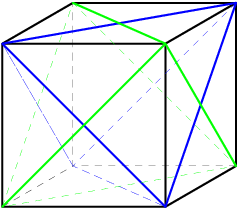

DPatrick
2011-02-09 19:54:52
One is blue, one is green.
One is blue, one is green.
DPatrick
2011-02-09 19:55:07
This picture is kind of noisy, though. Let's just look at the blue one.
This picture is kind of noisy, though. Let's just look at the blue one.
DPatrick
2011-02-09 19:55:14
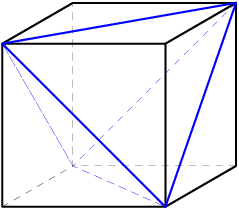

DPatrick
2011-02-09 19:55:25
What might be nice to know about this tetrahedron?
What might be nice to know about this tetrahedron?
fmasroor
2011-02-09 19:55:40
so how much volume does that have
so how much volume does that have
danielguo94
2011-02-09 19:55:40
its volume
its volume
the cliu
2011-02-09 19:55:40
its volume
its volume
DPatrick
2011-02-09 19:55:55
Right, that's probably helpful. How do we determine its volume?
Right, that's probably helpful. How do we determine its volume?
Uday J Uppal
2011-02-09 19:56:35
you could do complimentary counting: find volume of total cube and then subtract certain places.
you could do complimentary counting: find volume of total cube and then subtract certain places.
fmasroor
2011-02-09 19:56:35
subtracting the areas of the 'prisms' around it
subtracting the areas of the 'prisms' around it
DPatrick
2011-02-09 19:56:43
Right. It's the whole cube, minus 4 pieces.
Right. It's the whole cube, minus 4 pieces.
DPatrick
2011-02-09 19:57:11
Each missing piece is a pyramid with height 1 and whose base is a isosceles right triangle with legs 1. (This is easiest to see in the pic by looking at the cube vertex on top in the front right.)
Each missing piece is a pyramid with height 1 and whose base is a isosceles right triangle with legs 1. (This is easiest to see in the pic by looking at the cube vertex on top in the front right.)
mathlead
2011-02-09 19:57:30
find the base's area and multiply by height/3
find the base's area and multiply by height/3
chenboy3
2011-02-09 19:57:30
base*height/3
base*height/3
2redpartyhats
2011-02-09 19:57:30
(1/3) base*height
(1/3) base*height
DPatrick
2011-02-09 19:57:57
Right: each of these pyramidal pieces we have to cut away is a pyramid with height 1 and whose base is an isosceles right triangle with legs 1.
Right: each of these pyramidal pieces we have to cut away is a pyramid with height 1 and whose base is an isosceles right triangle with legs 1.
xxrxxhxx
2011-02-09 19:58:09
each piece has volume 1*1*1/2*1/3 = 1/6, subtract 4 of them to get 1/3 for the area of the tetrahedron
each piece has volume 1*1*1/2*1/3 = 1/6, subtract 4 of them to get 1/3 for the area of the tetrahedron
danielguo94
2011-02-09 19:58:11
The pieces have 1*1*1/2*1/3 = 1/6 volume each
The pieces have 1*1*1/2*1/3 = 1/6 volume each
DPatrick
2011-02-09 19:58:21
So each missing piece has volume (1/3)*(1/2)*1 = 1/6.
So each missing piece has volume (1/3)*(1/2)*1 = 1/6.
scgorantla
2011-02-09 19:58:37
and there are 4.
and there are 4.
PowerOfPi
2011-02-09 19:58:41
1-4*1/6 = 1/3
1-4*1/6 = 1/3
DPatrick
2011-02-09 19:58:51
Thus, the volume of each tetrahedron is 1 - 4(1/6) = 1/3.
Thus, the volume of each tetrahedron is 1 - 4(1/6) = 1/3.
DPatrick
2011-02-09 19:59:07
Using this, how do we compute the volume of the overlap?
Using this, how do we compute the volume of the overlap?
gaga654
2011-02-09 19:59:43
subtract the smaller tetrahedra not in the overlap
subtract the smaller tetrahedra not in the overlap
esque
2011-02-09 19:59:43
Subtract the smaller tetraherdons?
Subtract the smaller tetraherdons?
PowerOfPi
2011-02-09 19:59:43
subtract parts in blue tetrahedron but outside green tetrahedron
subtract parts in blue tetrahedron but outside green tetrahedron
DPatrick
2011-02-09 19:59:51
Right: let me put up the combined picture again:
Right: let me put up the combined picture again:
DPatrick
2011-02-09 19:59:57


DPatrick
2011-02-09 20:00:05
(I took the hidden sides out to make it easier to see)
(I took the hidden sides out to make it easier to see)
GeorgiaTechMan
2011-02-09 20:00:23
wouldn't there be four parts that are not in the green tetrahedron but in the blue tetrahedrons
wouldn't there be four parts that are not in the green tetrahedron but in the blue tetrahedrons
DPatrick
2011-02-09 20:00:45
Right. Where do the blue and green tetrahedra intersect?
Right. Where do the blue and green tetrahedra intersect?
Spring
2011-02-09 20:01:05
At the midpoints of the sides
At the midpoints of the sides
Uday J Uppal
2011-02-09 20:01:05
midpoint of the diagonals of the square faces
midpoint of the diagonals of the square faces
DPatrick
2011-02-09 20:01:08
Right.
Right.
DPatrick
2011-02-09 20:01:37
So there is a small tetrahedron, with sides exactly half the length, at each of the 4 vertices of the blue tetrahedron that is outside the green tetrahedron.
So there is a small tetrahedron, with sides exactly half the length, at each of the 4 vertices of the blue tetrahedron that is outside the green tetrahedron.
DPatrick
2011-02-09 20:01:50
(It can be hard to visualize this so think about it some more later if you don't see it right now.)
(It can be hard to visualize this so think about it some more later if you don't see it right now.)
GeorgiaTechMan
2011-02-09 20:02:02
so the area of each small tetrahedron is 1/2^3=1/8 the area of each of the large tetrahedra
so the area of each small tetrahedron is 1/2^3=1/8 the area of each of the large tetrahedra
AlphaMath1
2011-02-09 20:02:03
ratio of volumes = (1/2)^3=1/8
ratio of volumes = (1/2)^3=1/8
Spring
2011-02-09 20:02:03
So the volume is 1/8 of the large tetrahedron
So the volume is 1/8 of the large tetrahedron
PowerOfPi
2011-02-09 20:02:03
thus, its volume is (1/2)^3 = 1/8 of the big one
thus, its volume is (1/2)^3 = 1/8 of the big one
DPatrick
2011-02-09 20:02:16
Right: each small tetrahedron has (1/2)^3 = 1/8 of the volume of the big one.
Right: each small tetrahedron has (1/2)^3 = 1/8 of the volume of the big one.
DPatrick
2011-02-09 20:02:22
So removing four of them leaves 4/8 = 1/2 of the volume of the whole.
So removing four of them leaves 4/8 = 1/2 of the volume of the whole.
AlphaMath1
2011-02-09 20:02:38
1/2*1/3=1/6
1/2*1/3=1/6
GausssWill
2011-02-09 20:02:39
So 1/6
So 1/6
DPatrick
2011-02-09 20:02:51
Since the whole blue tetrahedron has volume 1/3, the common region has volume 1/2 * 1/3 = 1/6. Answer (D).
Since the whole blue tetrahedron has volume 1/3, the common region has volume 1/2 * 1/3 = 1/6. Answer (D).
DPatrick
2011-02-09 20:03:20
You could also do this problem directly by determining the region where they intersect and computing its volume directly, but I find this "cutting away pieces" solution more elegant.
You could also do this problem directly by determining the region where they intersect and computing its volume directly, but I find this "cutting away pieces" solution more elegant.
DPatrick
2011-02-09 20:03:48
Next is #25 on the AMC 10A, which is also #22 on the AMC 12A:
Next is #25 on the AMC 10A, which is also #22 on the AMC 12A:
DPatrick
2011-02-09 20:03:59


DPatrick
2011-02-09 20:04:38
How can we set this up?
How can we set this up?
GausssWill
2011-02-09 20:05:00
Draw a square
Draw a square
professordad
2011-02-09 20:05:00
diagram.
diagram.
googol.plex
2011-02-09 20:05:00
draw a square
draw a square
osmosis92
2011-02-09 20:05:00
first you need a square
first you need a square
DVA6102
2011-02-09 20:05:00
draw a square
draw a square
DPatrick
2011-02-09 20:05:13
You could draw it if it helps you visualize, but I didn't do a drawing.
You could draw it if it helps you visualize, but I didn't do a drawing.
Iggy Iguana
2011-02-09 20:05:28
Let R be a unit square and let X be (a,b)
Let R be a unit square and let X be (a,b)
DPatrick
2011-02-09 20:05:47
I'll do this (almost). To help with the calculations, we can assume that R is the unit square with lower-left corner (0,0), and let X = (x,y) be the point.
I'll do this (almost). To help with the calculations, we can assume that R is the unit square with lower-left corner (0,0), and let X = (x,y) be the point.
DPatrick
2011-02-09 20:06:05
What do we know about the rays?
What do we know about the rays?
AlphaMath1
2011-02-09 20:06:29
they must meet the vertices
they must meet the vertices
victorzhouaops
2011-02-09 20:06:30
4 of them must go to teh corners
4 of them must go to teh corners
briantix
2011-02-09 20:06:30
4 hit the corners
4 hit the corners
tan90
2011-02-09 20:06:30
Four of them must go through the verticies of the square
Four of them must go through the verticies of the square
GeorgiaTechMan
2011-02-09 20:06:30
there must be 4 reaching the vertices or else we have quadrilaterals too
there must be 4 reaching the vertices or else we have quadrilaterals too
DPatrick
2011-02-09 20:06:41
Since each region must be a triangle, we must have rays to the four corners of the square. Otherwise the corner is part of a quadrilateral.
Since each region must be a triangle, we must have rays to the four corners of the square. Otherwise the corner is part of a quadrilateral.
DPatrick
2011-02-09 20:06:57
So the triangles will all have their bases on one side of the square and have vertex X.
So the triangles will all have their bases on one side of the square and have vertex X.
DPatrick
2011-02-09 20:07:20
What do we know about the points where the rays hit the sides of the square?
What do we know about the points where the rays hit the sides of the square?
xixianxiang
2011-02-09 20:07:53
dividing sides into equal parts
dividing sides into equal parts
Kestzh
2011-02-09 20:07:53
equal lengths
equal lengths
fmasroor
2011-02-09 20:07:53
they have to have the same base
they have to have the same base
happystuff123
2011-02-09 20:07:53
They interesect at equal intervals
They interesect at equal intervals
CantonMathGuy
2011-02-09 20:07:53
they are equidistant
they are equidistant
prezcoin
2011-02-09 20:07:53
evenly spaced for each side
evenly spaced for each side
JSGandora
2011-02-09 20:07:53
they must be evenly spaced on both sides.
they must be evenly spaced on both sides.
DPatrick
2011-02-09 20:08:15
Right. Since to any side, all the triangles on that side will have the same height, and they must have the same area, they must all have the same base.
Right. Since to any side, all the triangles on that side will have the same height, and they must have the same area, they must all have the same base.
DPatrick
2011-02-09 20:08:23
So the rays must divide each side into pieces of equal size.
So the rays must divide each side into pieces of equal size.
DPatrick
2011-02-09 20:08:41
Let's set up some more notation so we can more easily talk about what's going on. Suppose that the rays divide the four sides (bottom, right, top, and left) into a, b, c, and d pieces.
Let's set up some more notation so we can more easily talk about what's going on. Suppose that the rays divide the four sides (bottom, right, top, and left) into a, b, c, and d pieces.
DPatrick
2011-02-09 20:08:53
What are the areas of the triangles?
What are the areas of the triangles?
connaissance
2011-02-09 20:09:08
1/n
1/n
prezcoin
2011-02-09 20:09:08
1/n
1/n
gaga654
2011-02-09 20:09:08
1/n
1/n
DPatrick
2011-02-09 20:09:17
Right. I didn't ask that question precisely enough.
Right. I didn't ask that question precisely enough.
DPatrick
2011-02-09 20:09:47
Let's look at the bottom first. If the point X = (x,y) and we divide the bottom into a pieces, what is the area of each triangle we get?
Let's look at the bottom first. If the point X = (x,y) and we divide the bottom into a pieces, what is the area of each triangle we get?
gh625
2011-02-09 20:10:23
y/2a
y/2a
connaissance
2011-02-09 20:10:24
y/(2a)
y/(2a)
ProbaBillity
2011-02-09 20:10:24
ay/2
ay/2
limac
2011-02-09 20:10:24
the base is 1/a, and height is y, so y/2a.
the base is 1/a, and height is y, so y/2a.
DPatrick
2011-02-09 20:10:54
Right. The height is y and the bases are each 1/a, so the area is y/2a.
Right. The height is y and the bases are each 1/a, so the area is y/2a.
DPatrick
2011-02-09 20:11:20


DPatrick
2011-02-09 20:11:58
But the triangles on all four sides have to have the same areas.
But the triangles on all four sides have to have the same areas.
DPatrick
2011-02-09 20:12:12


gaga654
2011-02-09 20:12:26
=1/n
=1/n
DPatrick
2011-02-09 20:12:32
...and indeed they all equal 1/n.
...and indeed they all equal 1/n.
DPatrick
2011-02-09 20:12:43
...actually I took the 1/2 out, so these all equal 2/n.
...actually I took the 1/2 out, so these all equal 2/n.
DPatrick
2011-02-09 20:12:51
How do we work with these equations?
How do we work with these equations?
simplyMathLete
2011-02-09 20:13:25
we could work with the a equation and the c one
we could work with the a equation and the c one
DPatrick
2011-02-09 20:13:42
That's an idea: we can use the first and third to solve for y.
That's an idea: we can use the first and third to solve for y.
DPatrick
2011-02-09 20:13:51
Solving for y seems like a good idea since we want to count the possible (x,y).
Solving for y seems like a good idea since we want to count the possible (x,y).
simplyMathLete
2011-02-09 20:14:17
manipulating, y = a/(a + c)
manipulating, y = a/(a + c)
AlphaMath1
2011-02-09 20:14:18
y/a=1-y/c cross multiplying gives cy=a-ay
y/a=1-y/c cross multiplying gives cy=a-ay
DPatrick
2011-02-09 20:14:25


rubiks3.14
2011-02-09 20:14:39
now do it for x
now do it for x
chenboy3
2011-02-09 20:14:44
now solve for x
now solve for x
DPatrick
2011-02-09 20:14:50


DPatrick
2011-02-09 20:15:37


DPatrick
2011-02-09 20:15:47
What else do we know?
What else do we know?
Iggy Iguana
2011-02-09 20:16:04
doesn't a+c=b+d
doesn't a+c=b+d
DPatrick
2011-02-09 20:16:12
How do we know this?
How do we know this?
csprunger95
2011-02-09 20:16:53
a little manipulation
a little manipulation
mathcricket
2011-02-09 20:16:53
cross multiplication
cross multiplication
AlphaMath1
2011-02-09 20:17:12
y/a=x/d ----> 1/a+c=1/b+d ----> a+c=b+d
y/a=x/d ----> 1/a+c=1/b+d ----> a+c=b+d
DPatrick
2011-02-09 20:17:29
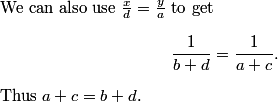

ilovepink
2011-02-09 20:17:39
doesn't a+c+b+d=n, because there are n triangles?
doesn't a+c+b+d=n, because there are n triangles?
DPatrick
2011-02-09 20:17:46
Aha, we have that information too.
Aha, we have that information too.
DPatrick
2011-02-09 20:17:55
Thus, since a+c = b+d, they are both equal to n/2.
Thus, since a+c = b+d, they are both equal to n/2.
gaga654
2011-02-09 20:18:13
so it's (2d/n,2a/n)
so it's (2d/n,2a/n)
chenboy3
2011-02-09 20:18:17
so X is now (2d/n,2a/n)
so X is now (2d/n,2a/n)
DPatrick
2011-02-09 20:18:37
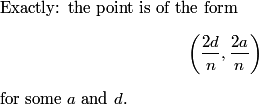

DPatrick
2011-02-09 20:18:48
What are the restrictions on a and d?
What are the restrictions on a and d?
rubiks3.14
2011-02-09 20:19:20
have to be less than n/2
have to be less than n/2
ilovepink
2011-02-09 20:19:20
a <n/2, d<n/2?
a <n/2, d<n/2?
DPatrick
2011-02-09 20:19:33
We need at least 1 triangle on each side, so we must have a and d be strictly between 0 and n/2.
We need at least 1 triangle on each side, so we must have a and d be strictly between 0 and n/2.
DPatrick
2011-02-09 20:19:44
Now what?
Now what?
girishvar12
2011-02-09 20:20:12
plug in numbers?
plug in numbers?
bulutcocuk
2011-02-09 20:20:13
start counting!
start counting!
vwu9
2011-02-09 20:20:21
plug in 60,100 for n?
plug in 60,100 for n?
DPatrick
2011-02-09 20:20:41
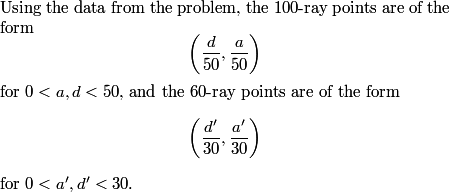

DPatrick
2011-02-09 20:21:05
First, how many of the 100-ray points are there?
First, how many of the 100-ray points are there?
Iggy Iguana
2011-02-09 20:21:25
49^2
49^2
gh625
2011-02-09 20:21:25
49^2
49^2
fractals
2011-02-09 20:21:25
49^2
49^2
danielguo94
2011-02-09 20:21:25
49^2
49^2
paperfury
2011-02-09 20:21:25
49*49
49*49
DPatrick
2011-02-09 20:21:36
a and d can each be between 1 and 49 (inclusive), so there are 49^2 of them.
a and d can each be between 1 and 49 (inclusive), so there are 49^2 of them.
DPatrick
2011-02-09 20:21:43
But when can a 100-ray point also be used as a 60-ray point?
But when can a 100-ray point also be used as a 60-ray point?
TachyonPulse
2011-02-09 20:22:24
when d/50 = d'/30 and a/50 = a'/30
when d/50 = d'/30 and a/50 = a'/30
rubiks3.14
2011-02-09 20:22:25
when a or d/50 can be translated to something else /30
when a or d/50 can be translated to something else /30
DPatrick
2011-02-09 20:22:33
Right: to do this, we need to be able to convert the denominator of 50 to a denominator of 30.
Right: to do this, we need to be able to convert the denominator of 50 to a denominator of 30.
danielguo94
2011-02-09 20:22:37
when a and d are divisble by 5
when a and d are divisble by 5
DPatrick
2011-02-09 20:22:53
Right. This gives a' = (3/5)a and d' = (3/5)d. But we can only do this is a and d are multiples of 5.
Right. This gives a' = (3/5)a and d' = (3/5)d. But we can only do this is a and d are multiples of 5.
gaga654
2011-02-09 20:23:10
there are 9^2 such points
there are 9^2 such points
Iggy Iguana
2011-02-09 20:23:10
there are 9*9=81 ways to not satisfy the problem.
there are 9*9=81 ways to not satisfy the problem.
VIPMaster
2011-02-09 20:23:10
there are 9 cases of this
there are 9 cases of this
DPatrick
2011-02-09 20:23:44
Indeed: there are 9 multiples of 5 between 0 and 50. When both a and d are both multiples of 5, those points have to be excluded from our earlier count. There are 9 multiples of 5, so there are 9^2 pairs.
Indeed: there are 9 multiples of 5 between 0 and 50. When both a and d are both multiples of 5, those points have to be excluded from our earlier count. There are 9 multiples of 5, so there are 9^2 pairs.
Iggy Iguana
2011-02-09 20:23:56
49^2 - 9^2 = 58*40 = 2320.
49^2 - 9^2 = 58*40 = 2320.
briantix
2011-02-09 20:23:57
so 2401-81=2320?
so 2401-81=2320?
DVA6102
2011-02-09 20:23:57
:.(49+9)(49-9)
:.(49+9)(49-9)
fractals
2011-02-09 20:24:05
49^2 total and 9^2 that don't satisfy, so 49^2-9^2=(49-9)(49+9)=20*78=2320 (C)
49^2 total and 9^2 that don't satisfy, so 49^2-9^2=(49-9)(49+9)=20*78=2320 (C)
DPatrick
2011-02-09 20:24:07


DPatrick
2011-02-09 20:24:41
To me this was clearly the hardest problem on the 10A. It required several steps to get from start to finish.
To me this was clearly the hardest problem on the 10A. It required several steps to get from start to finish.
DPatrick
2011-02-09 20:25:30
I am going to take a 2-minute break to give my fingers a rest from typing, and then we'll come back with #21 on the AMC12.
I am going to take a 2-minute break to give my fingers a rest from typing, and then we'll come back with #21 on the AMC12.
DPatrick
2011-02-09 20:27:44
OK, I'm back and I've got my second wind now. :)
OK, I'm back and I've got my second wind now. :)
DPatrick
2011-02-09 20:27:56
We'll continue with #21 from the AMC 12:
We'll continue with #21 from the AMC 12:
DPatrick
2011-02-09 20:28:03


DPatrick
2011-02-09 20:28:27
First, be sure you understand the notation.
First, be sure you understand the notation.
DPatrick
2011-02-09 20:28:33


DPatrick
2011-02-09 20:28:56
How can we approach this problem?
How can we approach this problem?
lg5293
2011-02-09 20:29:17
find domain at each step
find domain at each step
AlphaMath1
2011-02-09 20:29:17
Start with f_1 and work your way upwards?
Start with f_1 and work your way upwards?
moplam
2011-02-09 20:29:17
look at domain of f_1 then f_2, etc
look at domain of f_1 then f_2, etc
BarbieRocks
2011-02-09 20:29:17
first few cases
first few cases
DPatrick
2011-02-09 20:29:26
Let's just try to keep track of the domains and see where it gets us.
Let's just try to keep track of the domains and see where it gets us.
DPatrick
2011-02-09 20:29:33
What is the domain of f_1?
What is the domain of f_1?
VIPMaster
2011-02-09 20:30:02
x<=1
x<=1
Ttocs45
2011-02-09 20:30:02
x <= 1
x <= 1
connaissance
2011-02-09 20:30:02
x<=1
x<=1
xxrxxhxx
2011-02-09 20:30:02
(-inf, 1]
(-inf, 1]
DPatrick
2011-02-09 20:30:09


DPatrick
2011-02-09 20:30:31


DPatrick
2011-02-09 20:30:41
What is the domain of f_2?
What is the domain of f_2?
DPatrick
2011-02-09 20:31:20
How can we figure it out systematically?
How can we figure it out systematically?
gh625
2011-02-09 20:31:26
sqrt{4-x}<=1
sqrt{4-x}<=1
DPatrick
2011-02-09 20:31:37


DPatrick
2011-02-09 20:32:03
What inequality does this give us for x?
What inequality does this give us for x?
EricMathPath09
2011-02-09 20:32:13
3<=x<=4
3<=x<=4
xxrxxhxx
2011-02-09 20:32:13
3<=x<=4
3<=x<=4
christerson
2011-02-09 20:32:13
3<= x <= 4
3<= x <= 4
DPatrick
2011-02-09 20:32:28


DPatrick
2011-02-09 20:32:36


DPatrick
2011-02-09 20:32:42
Now what?
Now what?
lg5293
2011-02-09 20:32:51
now go to f_3
now go to f_3
BarbieRocks
2011-02-09 20:32:55
keep going?
keep going?
theax
2011-02-09 20:32:55
same thing!
same thing!
DPatrick
2011-02-09 20:32:59
What is the domain of f_3?
What is the domain of f_3?
moplam
2011-02-09 20:33:17
3<=sqrt(9-x)<=4
3<=sqrt(9-x)<=4
iamnew
2011-02-09 20:33:18
feed sqrt(9-x) in that
feed sqrt(9-x) in that
lg5293
2011-02-09 20:33:18
3 <= sqrt{9-x} <= 4
3 <= sqrt{9-x} <= 4
gaga654
2011-02-09 20:33:18
3<=sqrt{9-x}<=4
3<=sqrt{9-x}<=4
DPatrick
2011-02-09 20:33:22


DPatrick
2011-02-09 20:33:40
What does that give for x?
What does that give for x?
moplam
2011-02-09 20:33:56
9<=9-x<=16 --> -7 <= x <=0
9<=9-x<=16 --> -7 <= x <=0
ilovepink
2011-02-09 20:33:56
-7<=x<=0
-7<=x<=0
GeorgiaTechMan
2011-02-09 20:33:56
so -7 <=x<=0
so -7 <=x<=0
fractals
2011-02-09 20:33:56
-7<=x<=0
-7<=x<=0
DPatrick
2011-02-09 20:34:12


DPatrick
2011-02-09 20:34:18


fmasroor
2011-02-09 20:34:26
isn't this eventually gonna end?
isn't this eventually gonna end?
DPatrick
2011-02-09 20:34:29
I hope so!
I hope so!
centralbs
2011-02-09 20:34:34
and our next radical cannot be negative, so it must equal zero
and our next radical cannot be negative, so it must equal zero
DPatrick
2011-02-09 20:34:43
Aha...this seems important!
Aha...this seems important!
DPatrick
2011-02-09 20:34:57


JamesTianyQiaoMa
2011-02-09 20:35:07
sqrt(16-x)=0
sqrt(16-x)=0
moplam
2011-02-09 20:35:07
well, for f_4, sqrt( 16 -x) = 0 is the only case
well, for f_4, sqrt( 16 -x) = 0 is the only case
DPatrick
2011-02-09 20:35:25
But sqrt(16-x) is nonnegative by definition, and the only nonnegative number that f_3 can take is 0.
But sqrt(16-x) is nonnegative by definition, and the only nonnegative number that f_3 can take is 0.
DPatrick
2011-02-09 20:35:35


VIPMaster
2011-02-09 20:35:44
But be careful, this is not the last case
But be careful, this is not the last case
EricMathPath09
2011-02-09 20:35:47
We have not shown this to be the largest value of N, though./
We have not shown this to be the largest value of N, though./
DPatrick
2011-02-09 20:36:06
Indeed, there's a trap here. The problem asked for the LARGEST value of n with a single number in its domain, not the smallest.
Indeed, there's a trap here. The problem asked for the LARGEST value of n with a single number in its domain, not the smallest.
DPatrick
2011-02-09 20:36:12
So we have to keep going!
So we have to keep going!
DPatrick
2011-02-09 20:36:26


DPatrick
2011-02-09 20:36:36
oops...scratch that...
oops...scratch that...
DPatrick
2011-02-09 20:36:45


paperfury
2011-02-09 20:37:04
Thus, x=-231
Thus, x=-231
Ttocs45
2011-02-09 20:37:04
x must be -231
x must be -231
simplyMathLete
2011-02-09 20:37:04
x = -231
x = -231
JamesTianyQiaoMa
2011-02-09 20:37:04
x=-231
x=-231
DPatrick
2011-02-09 20:37:10


DPatrick
2011-02-09 20:37:17


AlphaMath1
2011-02-09 20:37:29
next radical cannot equal -231
next radical cannot equal -231
gaga654
2011-02-09 20:37:29
this is the last one that works
this is the last one that works
simplyMathLete
2011-02-09 20:37:29
and that's the last one! because x is negative
and that's the last one! because x is negative
DPatrick
2011-02-09 20:37:44


DPatrick
2011-02-09 20:38:06
But that can't happen, since the left side of the above equation can't be negative.
But that can't happen, since the left side of the above equation can't be negative.
paperfury
2011-02-09 20:38:13
So c=-231 and N=5
So c=-231 and N=5
DPatrick
2011-02-09 20:38:19
Aha, we're done! We have N=5 and c = -231.
Aha, we're done! We have N=5 and c = -231.
BarbieRocks
2011-02-09 20:38:29
5+(-231)=-226 (A)
5+(-231)=-226 (A)
xixianxiang
2011-02-09 20:38:29
hence -231+5 = -226
hence -231+5 = -226
chenboy3
2011-02-09 20:38:29
therefore the sum is -231+5=-226
therefore the sum is -231+5=-226
DPatrick
2011-02-09 20:38:34
Their sum is -226. Answer (A).
Their sum is -226. Answer (A).
DPatrick
2011-02-09 20:38:59
We already did #22: it was the n-ray partition problem.
We already did #22: it was the n-ray partition problem.
DPatrick
2011-02-09 20:39:03
So we'll press on to #23:
So we'll press on to #23:
DPatrick
2011-02-09 20:39:10


DPatrick
2011-02-09 20:39:32
How can we approach this?
How can we approach this?
Caelestor
2011-02-09 20:39:51
find an expression for g(z)
find an expression for g(z)
Cortana
2011-02-09 20:39:52
find g(z)
find g(z)
lg5293
2011-02-09 20:39:52
see what f(f(z)) is
see what f(f(z)) is
DPatrick
2011-02-09 20:39:58
Maybe we should try to write down what these functions are.
Maybe we should try to write down what these functions are.
DPatrick
2011-02-09 20:40:08
First, we can write down g(z) by plugging in f(z) for z in the definition of f(z):
First, we can write down g(z) by plugging in f(z) for z in the definition of f(z):
DPatrick
2011-02-09 20:40:14


DPatrick
2011-02-09 20:40:29
(You guys shouldn't try to type in these expressions ... I'll do the icky algebra for you!)
(You guys shouldn't try to type in these expressions ... I'll do the icky algebra for you!)
fmasroor
2011-02-09 20:40:41
lets simplify that a little bit
lets simplify that a little bit
DPatrick
2011-02-09 20:40:47
Multiplying numerator and denominator by z+b simplifies this:
Multiplying numerator and denominator by z+b simplifies this:
DPatrick
2011-02-09 20:40:52


DPatrick
2011-02-09 20:41:12
We could try to write an expression for g(g(z)), but that seems messy.
We could try to write an expression for g(g(z)), but that seems messy.
DPatrick
2011-02-09 20:41:44
Rather than expand g(g(z)) all the way out, what else could we try?
Rather than expand g(g(z)) all the way out, what else could we try?
theax
2011-02-09 20:41:54
g(z) is its own inverse function!
g(z) is its own inverse function!
DPatrick
2011-02-09 20:42:01
How does that help?
How does that help?
PowerOfPi
2011-02-09 20:42:17
switch g(z) and z
switch g(z) and z
DPatrick
2011-02-09 20:42:47
Aha! If we flip z and g(z) in the above expression, it will still be true! That's because g(z) is its own inverse.
Aha! If we flip z and g(z) in the above expression, it will still be true! That's because g(z) is its own inverse.
DPatrick
2011-02-09 20:42:57


DPatrick
2011-02-09 20:43:17
What do we want to do with this?
What do we want to do with this?
BarbieRocks
2011-02-09 20:43:34
solve for g(z)
solve for g(z)
VIPMaster
2011-02-09 20:43:34
Now we can get g(z) in terms of z
Now we can get g(z) in terms of z
centralbs
2011-02-09 20:43:34
Solve for g(z).... :(
Solve for g(z).... :(
GeorgiaTechMan
2011-02-09 20:43:34
could we find g(z) in terms of z using this?
could we find g(z) in terms of z using this?
gh625
2011-02-09 20:43:34
Solve for g(z) and set it equal to the original expression for g(z)
Solve for g(z) and set it equal to the original expression for g(z)
DPatrick
2011-02-09 20:43:40
Indeed: we can solve for g(z), and compare it to our earlier expression for g(z):
Indeed: we can solve for g(z), and compare it to our earlier expression for g(z):
DPatrick
2011-02-09 20:43:51
Again, I'll do the messy algebra for you. :)
Again, I'll do the messy algebra for you. :)
DPatrick
2011-02-09 20:43:57


DPatrick
2011-02-09 20:44:08


DPatrick
2011-02-09 20:44:17


xixianxiang
2011-02-09 20:44:41
equate the two expressions
equate the two expressions
DPatrick
2011-02-09 20:44:43
And we can equate this to our earlier equation for g(z) (that I saved up at the top):
And we can equate this to our earlier equation for g(z) (that I saved up at the top):
DPatrick
2011-02-09 20:44:48


GeorgiaTechMan
2011-02-09 20:45:01
cross multiply
cross multiply
DPatrick
2011-02-09 20:45:06


jeanlucwat
2011-02-09 20:45:11
this is getting messy...
this is getting messy...
DPatrick
2011-02-09 20:45:19
True, but the pretty part is coming up soon!
True, but the pretty part is coming up soon!
DPatrick
2011-02-09 20:45:39
I don't want to expand it all out necessarily...what do I want to do?
I don't want to expand it all out necessarily...what do I want to do?
penguinshin
2011-02-09 20:46:00
equate the constants?
equate the constants?
DPatrick
2011-02-09 20:46:20
Even more than that: I have a quadratic on both sides that are equal, so let's equal the z^2, z, and constant coefficents:
Even more than that: I have a quadratic on both sides that are equal, so let's equal the z^2, z, and constant coefficents:
DPatrick
2011-02-09 20:46:26


DPatrick
2011-02-09 20:46:37


jeanlucwat
2011-02-09 20:46:59
divide by a+ab
divide by a+ab
Cortana
2011-02-09 20:46:59
(a+ab) cancel
(a+ab) cancel
DPatrick
2011-02-09 20:47:05
No can do. Why not?
No can do. Why not?
gh625
2011-02-09 20:47:14
it could be 0
it could be 0
Caelestor
2011-02-09 20:47:14
might be 0
might be 0
centralbs
2011-02-09 20:47:14
It could equal zero
It could equal zero
andrewjjiang97
2011-02-09 20:47:14
Could be 0
Could be 0
DPatrick
2011-02-09 20:47:20
Right. And that's the whole point!
Right. And that's the whole point!
DPatrick
2011-02-09 20:47:32
If I clean up my system a little by factoring common factors, I get:
If I clean up my system a little by factoring common factors, I get:
DPatrick
2011-02-09 20:47:41


DPatrick
2011-02-09 20:48:02
What do we conclude from this system?
What do we conclude from this system?
centralbs
2011-02-09 20:48:11
b=-1 works
b=-1 works
calculus321
2011-02-09 20:48:12
b=-1
b=-1
DPatrick
2011-02-09 20:48:22
b = -1 is certainly a solution.
b = -1 is certainly a solution.
DPatrick
2011-02-09 20:48:38
And if b is anything other than -1, what must we have?
And if b is anything other than -1, what must we have?
simplyMathLete
2011-02-09 20:48:56
the other is 1 + 2a + b^2 = 0
the other is 1 + 2a + b^2 = 0
fractals
2011-02-09 20:48:56
b^2+2a+1=0
b^2+2a+1=0
gh625
2011-02-09 20:48:56
1+2a+b^2=0
1+2a+b^2=0
xxrxxhxx
2011-02-09 20:48:56
1+2a+b^2 = 0
1+2a+b^2 = 0
DPatrick
2011-02-09 20:49:12
Right, otherwise we must have 1 + 2a + b^2 = 0.
Right, otherwise we must have 1 + 2a + b^2 = 0.
VIPMaster
2011-02-09 20:49:31
|a| = 1, that would be useful right about now!
|a| = 1, that would be useful right about now!
DPatrick
2011-02-09 20:49:43
Indeed, given that |a| = 1, what do we know about |b|?
Indeed, given that |a| = 1, what do we know about |b|?
jeanlucwat
2011-02-09 20:50:01
-1-2a=b^2
-1-2a=b^2
DPatrick
2011-02-09 20:50:22


DPatrick
2011-02-09 20:50:39
What are the possible values of |1+2a| if we know |a| = 1?
What are the possible values of |1+2a| if we know |a| = 1?
jraz27
2011-02-09 20:51:12
3 or 1
3 or 1
andrewjjiang97
2011-02-09 20:51:12
3, 1
3, 1
Iggy Iguana
2011-02-09 20:51:12
1 or 3
1 or 3
christerson
2011-02-09 20:51:12
3 or 1
3 or 1
bulutcocuk
2011-02-09 20:51:12
1 , 3
1 , 3
DPatrick
2011-02-09 20:51:33
Certainly a=1 gives |b|^2 = 3 and a=-1 gives |b| = 1.
Certainly a=1 gives |b|^2 = 3 and a=-1 gives |b| = 1.
DPatrick
2011-02-09 20:51:49
In the complex plane it can take any value in between too, but we only care about the largest and smallest.
In the complex plane it can take any value in between too, but we only care about the largest and smallest.
DPatrick
2011-02-09 20:52:04


DPatrick
2011-02-09 20:52:31
We'll continue on to #24:
We'll continue on to #24:
DPatrick
2011-02-09 20:52:37


theone142857
2011-02-09 20:53:03
Answer choices
Answer choices
DPatrick
2011-02-09 20:53:14
Oops, these are the choices from the last problem! :(
Oops, these are the choices from the last problem! :(
DPatrick
2011-02-09 20:53:32
hang on a sec...
hang on a sec...
DPatrick
2011-02-09 20:54:03


DPatrick
2011-02-09 20:54:10
Better? :)
Better? :)
DPatrick
2011-02-09 20:54:19
What can we say about the largest possible circle that fits inside quadrilateral ABCD?
What can we say about the largest possible circle that fits inside quadrilateral ABCD?
BarbieRocks
2011-02-09 20:54:37
Opposite sides dd up to the same thing, so it MUST have an incircle.
Opposite sides dd up to the same thing, so it MUST have an incircle.
gomath888
2011-02-09 20:54:37
inscribed
inscribed
megahertz
2011-02-09 20:54:37
it is tangent to the sides
it is tangent to the sides
bulutcocuk
2011-02-09 20:54:37
it touches the boundaries
it touches the boundaries
chenboy3
2011-02-09 20:54:37
it must border all sides of the quadrilateral
it must border all sides of the quadrilateral
DPatrick
2011-02-09 20:54:41
The largest possible circle that fits inside quadrilateral ABCD is the circle that is tangent to all sides, also known as the incircle of quadrilateral ABCD.
The largest possible circle that fits inside quadrilateral ABCD is the circle that is tangent to all sides, also known as the incircle of quadrilateral ABCD.
DPatrick
2011-02-09 20:54:48
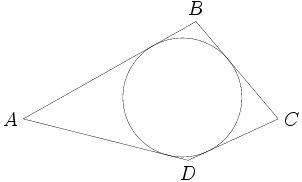

GeorgiaTechMan
2011-02-09 20:54:58
it is inscribed in quadrilateral ABCD since AB+CD=BC+AD
it is inscribed in quadrilateral ABCD since AB+CD=BC+AD
DPatrick
2011-02-09 20:55:09
Quadrilateral ABCD has an incircle if and only if AB + CD = BC + DA, which is the case here. This is a standard result in quadrilaterals. (It's also not hard to prove if you'd like to try it as an exercise, but I'll skip this now.)
Quadrilateral ABCD has an incircle if and only if AB + CD = BC + DA, which is the case here. This is a standard result in quadrilaterals. (It's also not hard to prove if you'd like to try it as an exercise, but I'll skip this now.)
DPatrick
2011-02-09 20:55:22
And if a quadrilateral has an incircle, then it is clearly the largest circle that fits inside the quadrilateral.
And if a quadrilateral has an incircle, then it is clearly the largest circle that fits inside the quadrilateral.
DPatrick
2011-02-09 20:55:33
What can we say about the radius of the incircle? How does it relate to the quadrilateral?
What can we say about the radius of the incircle? How does it relate to the quadrilateral?
BarbieRocks
2011-02-09 20:55:54
Just like a triangle, A=rs
Just like a triangle, A=rs
lg5293
2011-02-09 20:55:54
area = rs?
area = rs?
zero.destroyer
2011-02-09 20:55:54
rs=area
rs=area
simplyMathLete
2011-02-09 20:55:54
rs = Area
rs = Area
DPatrick
2011-02-09 20:56:04
The radius of the incircle is given by r = K/s, where K is the area of the quadrilateral, and s is the semi-perimeter (half the perimeter) of the quadrilateral. This is the same formula as for the triangle, and it is derived the same way as well. (It's a fun exercise to try to do this yourself if you've never seen this before.)
The radius of the incircle is given by r = K/s, where K is the area of the quadrilateral, and s is the semi-perimeter (half the perimeter) of the quadrilateral. This is the same formula as for the triangle, and it is derived the same way as well. (It's a fun exercise to try to do this yourself if you've never seen this before.)
DPatrick
2011-02-09 20:56:16
Since we are given the sides of the quadrilateral, we can compute the semi-perimeter s.
Since we are given the sides of the quadrilateral, we can compute the semi-perimeter s.
GeorgiaTechMan
2011-02-09 20:56:30
it is 21.
it is 21.
christopher.jedi
2011-02-09 20:56:30
21
21
DPatrick
2011-02-09 20:56:34
The semi-perimeter s is (14 + 9 + 7 + 12)/2 = 21.
The semi-perimeter s is (14 + 9 + 7 + 12)/2 = 21.
DPatrick
2011-02-09 20:56:43
Hence, the radius we want is r = K/21. Thus, maximizing the radius is equivalent to maximizing the area.
Hence, the radius we want is r = K/21. Thus, maximizing the radius is equivalent to maximizing the area.
DPatrick
2011-02-09 20:56:53
So how do we maximize the area?
So how do we maximize the area?
BarbieRocks
2011-02-09 20:57:08
K is maximizied when its a cyclic quadrilateral.
K is maximizied when its a cyclic quadrilateral.
Cortana
2011-02-09 20:57:08
ABCD is cyclic
ABCD is cyclic
AlphaMath1
2011-02-09 20:57:08
quadrilateral is cyclic?
quadrilateral is cyclic?
Cortana
2011-02-09 20:57:08
Abcd is cyclic
Abcd is cyclic
bulutcocuk
2011-02-09 20:57:08
assume it's cyclic?
assume it's cyclic?
DPatrick
2011-02-09 20:57:46
Indeed, the area is maximized if the quadrilateral is cyclic (meaning we can circumscribe a circle around it containing all 4 vertices).
Indeed, the area is maximized if the quadrilateral is cyclic (meaning we can circumscribe a circle around it containing all 4 vertices).
NuncChaos
2011-02-09 20:57:55
why necessarily cyclic?
why necessarily cyclic?
antybash
2011-02-09 20:57:55
how do we prove it must be cyclic?
how do we prove it must be cyclic?
DPatrick
2011-02-09 20:58:09
Here's quickie argument since I don't have time for a full proof:
Here's quickie argument since I don't have time for a full proof:
DPatrick
2011-02-09 20:58:17
Imagine it's cyclic to begin with:
Imagine it's cyclic to begin with:
DPatrick
2011-02-09 20:58:23
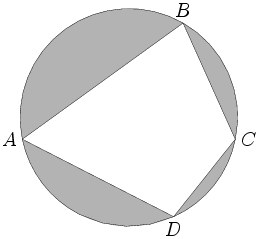

DPatrick
2011-02-09 20:58:32
The sides of the quadrilateral cut off four circular sectors in the circle.
The sides of the quadrilateral cut off four circular sectors in the circle.
DPatrick
2011-02-09 20:58:52
Now if I flex the quadrilateral and drag the sectors with it (but don't change them), I get something like this:
Now if I flex the quadrilateral and drag the sectors with it (but don't change them), I get something like this:
DPatrick
2011-02-09 20:59:01
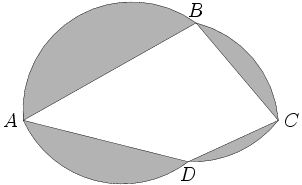

DPatrick
2011-02-09 20:59:35
This has the same perimeter as my earlier circle, so it must have smaller area (since a circle is the maximum area for a given perimeter; this is often called the Isoperimetric Theorem).
This has the same perimeter as my earlier circle, so it must have smaller area (since a circle is the maximum area for a given perimeter; this is often called the Isoperimetric Theorem).
DPatrick
2011-02-09 21:00:01
So the cyclic quadrilateral is the one with the largest area (given a fixed set of side lengths).
So the cyclic quadrilateral is the one with the largest area (given a fixed set of side lengths).
DPatrick
2011-02-09 21:00:18
So we'll want ABCD to be cyclic in order to maximize the area.
So we'll want ABCD to be cyclic in order to maximize the area.
theone142857
2011-02-09 21:00:39
So A+C=180
So A+C=180
simplyMathLete
2011-02-09 21:00:39
can we use Brahmagupta's formula?
can we use Brahmagupta's formula?
bulutcocuk
2011-02-09 21:00:39
brahmagupta!
brahmagupta!
hrithikguy
2011-02-09 21:00:45
use brahmagupta
use brahmagupta
DPatrick
2011-02-09 21:00:56
There is a magic formula we could use now that blows the problem up.
There is a magic formula we could use now that blows the problem up.
DPatrick
2011-02-09 21:01:13
You can look this up on the forum.
You can look this up on the forum.
DPatrick
2011-02-09 21:01:32
But let's assume you don't know the formula (like me).
But let's assume you don't know the formula (like me).
DPatrick
2011-02-09 21:01:49
We can compute the area directly. Here's a picture:
We can compute the area directly. Here's a picture:
DPatrick
2011-02-09 21:01:56
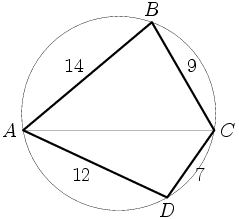

DPatrick
2011-02-09 21:02:22
I drew diagonal AC because I know how to work with triangles.
I drew diagonal AC because I know how to work with triangles.
danielguo94
2011-02-09 21:02:47
law of cosines/sines
law of cosines/sines
xixianxiang
2011-02-09 21:02:53
1/2 12*7sinD + 1/2 9*14 sinB
1/2 12*7sinD + 1/2 9*14 sinB
DPatrick
2011-02-09 21:02:56
Indeed.
Indeed.
DPatrick
2011-02-09 21:03:07


DPatrick
2011-02-09 21:03:15


DPatrick
2011-02-09 21:03:25


RisingMathStar
2011-02-09 21:03:35
angles B and D are supplementary
angles B and D are supplementary
tan90
2011-02-09 21:03:36
sin B = sin D
sin B = sin D
exmath89
2011-02-09 21:03:36
<B+<D=180
<B+<D=180
TachyonPulse
2011-02-09 21:03:36
sin B = sin D because B + D = 180
sin B = sin D because B + D = 180
DPatrick
2011-02-09 21:03:43
Aha: since our ABCD is cyclic, we do know sin B = sin D because the angles are supplementary.
Aha: since our ABCD is cyclic, we do know sin B = sin D because the angles are supplementary.
DPatrick
2011-02-09 21:03:54
So K = 105 sin B.
So K = 105 sin B.
DPatrick
2011-02-09 21:04:02
That's good, but we don't know sin B. What can we do?
That's good, but we don't know sin B. What can we do?
JamesTianyQiaoMa
2011-02-09 21:04:14
law of cosines
law of cosines
silverchocolate
2011-02-09 21:04:14
law of cosineas
law of cosineas
DPatrick
2011-02-09 21:04:22
We can compute AC two different ways by the Law of Cosines.
We can compute AC two different ways by the Law of Cosines.
mathwiz314
2011-02-09 21:04:28
set the law of cos equal to each other
set the law of cos equal to each other
DPatrick
2011-02-09 21:04:33


DPatrick
2011-02-09 21:04:47


DPatrick
2011-02-09 21:05:03


DVA6102
2011-02-09 21:05:17
B and D are supplementary
B and D are supplementary
tan90
2011-02-09 21:05:17
cos B = -cos D
cos B = -cos D
christerson
2011-02-09 21:05:17
cos B = -cos D
cos B = -cos D
DPatrick
2011-02-09 21:05:24
But the quadrilateral is cyclic, so cos D = -cos B.
But the quadrilateral is cyclic, so cos D = -cos B.
DPatrick
2011-02-09 21:05:38
Thus we have (after simplification) 21 = 105 cos B, hence cos B = 21/105 = 1/5.
Thus we have (after simplification) 21 = 105 cos B, hence cos B = 21/105 = 1/5.
DPatrick
2011-02-09 21:05:54
Now we just back everything out of our calculations.
Now we just back everything out of our calculations.
DPatrick
2011-02-09 21:06:07


DPatrick
2011-02-09 21:06:18


DPatrick
2011-02-09 21:06:28


VIPMaster
2011-02-09 21:07:07
Would Brahmagupta's formula make this easier? i.e. Could you still use it and get the same answer?
Would Brahmagupta's formula make this easier? i.e. Could you still use it and get the same answer?
DPatrick
2011-02-09 21:07:26
Yes, it does. But then you have to spend your time memorizing semi-obscure geometry formulas.
Yes, it does. But then you have to spend your time memorizing semi-obscure geometry formulas.
DPatrick
2011-02-09 21:07:43
Let's go on to #25:
Let's go on to #25:
DPatrick
2011-02-09 21:07:50


DPatrick
2011-02-09 21:08:08
(As a matter of taste, I'm not fond of both #24 and #25 being "maximize the area" problems, but on the other hand the methods are very different.)
(As a matter of taste, I'm not fond of both #24 and #25 being "maximize the area" problems, but on the other hand the methods are very different.)
Anamfija
2011-02-09 21:08:24
draw a picture
draw a picture
andrewjjiang97
2011-02-09 21:08:25
diagram
diagram
DPatrick
2011-02-09 21:08:32
Of course, we can start with a diagram. Unfortunately, it looks like this:
Of course, we can start with a diagram. Unfortunately, it looks like this:
DPatrick
2011-02-09 21:08:38
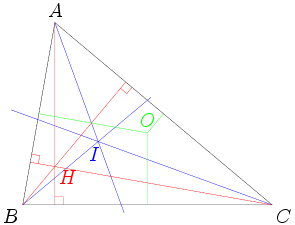

DPatrick
2011-02-09 21:08:45
I drew it with different colors to try to keep track of the different points, but it's still a bit of a mess.
I drew it with different colors to try to keep track of the different points, but it's still a bit of a mess.
DPatrick
2011-02-09 21:09:05
Not only is this a blizzard of lines and points, it we don't draw the diagram very precisely, we might end up being very unsure of the relative locations of H, I, and O. Moreover, there's so much going on in this diagram that it will be very hard to keep track of all the information we need to follow.
Not only is this a blizzard of lines and points, it we don't draw the diagram very precisely, we might end up being very unsure of the relative locations of H, I, and O. Moreover, there's so much going on in this diagram that it will be very hard to keep track of all the information we need to follow.
DPatrick
2011-02-09 21:09:19
Any ideas how to make it simpler?
Any ideas how to make it simpler?
centralbs
2011-02-09 21:09:29
Make 3 diagrams?
Make 3 diagrams?
christopher.jedi
2011-02-09 21:09:38
one at a time
one at a time
DPatrick
2011-02-09 21:09:47
We can break up the diagram and make one each for the circumcenter, incenter, and orthocenter, and learn what we can in each of those diagrams. Hopefully, we'll be able to combine that information in some useful way.
We can break up the diagram and make one each for the circumcenter, incenter, and orthocenter, and learn what we can in each of those diagrams. Hopefully, we'll be able to combine that information in some useful way.
DPatrick
2011-02-09 21:10:14
Let's start with the circumcenter (for no particularly good reason):
Let's start with the circumcenter (for no particularly good reason):
DPatrick
2011-02-09 21:10:23
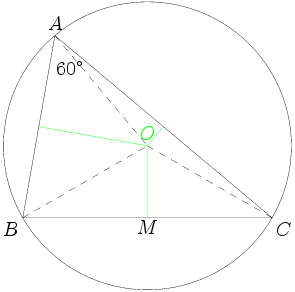

DPatrick
2011-02-09 21:10:35
What can we learn from this diagram?
What can we learn from this diagram?
Goutham
2011-02-09 21:10:54
BOC is isosceles
BOC is isosceles
tan90
2011-02-09 21:11:02
The circumradius = sqrt3 / 3
The circumradius = sqrt3 / 3
DPatrick
2011-02-09 21:11:13
Since <BAC = 60, arc BC is 120 degrees, so <BOC = 120.
Since <BAC = 60, arc BC is 120 degrees, so <BOC = 120.
DPatrick
2011-02-09 21:11:28
Therefore, angles OBC and OCB are each 30 degrees.
Therefore, angles OBC and OCB are each 30 degrees.
thecmd999
2011-02-09 21:11:40
30 60 90?
30 60 90?
DPatrick
2011-02-09 21:11:54
Right, BOM and COM are each 30-60-90, so we get some lengths too. (Recall BC = 1.)
Right, BOM and COM are each 30-60-90, so we get some lengths too. (Recall BC = 1.)
GeorgiaTechMan
2011-02-09 21:12:03
so BO=OC=OA=1/sqrt3=sqrt3/3
so BO=OC=OA=1/sqrt3=sqrt3/3
DPatrick
2011-02-09 21:12:20
Since BC is 1, we have BM = 1/2, OM = 1/(2sqrt(3)), and the circumradius is 1/sqrt(3). Maybe that will be useful. I'll add this data to the pic:
Since BC is 1, we have BM = 1/2, OM = 1/(2sqrt(3)), and the circumradius is 1/sqrt(3). Maybe that will be useful. I'll add this data to the pic:
DPatrick
2011-02-09 21:12:31
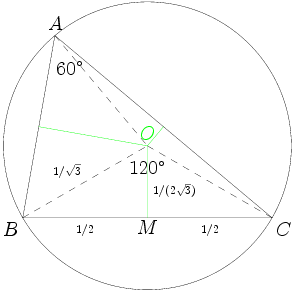

DPatrick
2011-02-09 21:12:53
Hmmm...we seem to have exhausted this picture.
Hmmm...we seem to have exhausted this picture.
DPatrick
2011-02-09 21:13:01
Let's move over to the incenter pic:
Let's move over to the incenter pic:
DPatrick
2011-02-09 21:13:08
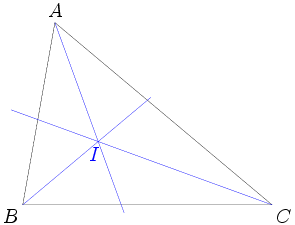

DPatrick
2011-02-09 21:13:36
Can we chase any angles or lengths?
Can we chase any angles or lengths?
mathtyro
2011-02-09 21:13:49
Yes, since we have angle bisectors.
Yes, since we have angle bisectors.
mathnerd101
2011-02-09 21:13:49
the angles are bisected
the angles are bisected
Ttocs45
2011-02-09 21:14:08
angle BAI = angle CAI = 30
angle BAI = angle CAI = 30
DPatrick
2011-02-09 21:14:48
Right, all of these blue lines are angle bisectors. So <BAI and <CAI are each 30.
Right, all of these blue lines are angle bisectors. So <BAI and <CAI are each 30.
DPatrick
2011-02-09 21:15:03
How about <BIC? Any info about it?
How about <BIC? Any info about it?
Cortana
2011-02-09 21:15:21
BIC= 120
BIC= 120
capu
2011-02-09 21:15:22
120?
120?
DPatrick
2011-02-09 21:15:24
How come?
How come?
Goutham
2011-02-09 21:15:47
90+A/2
90+A/2
Letti
2011-02-09 21:15:47
because 180-30-30=120
because 180-30-30=120
PowerOfPi
2011-02-09 21:15:47
use triangle BIC
use triangle BIC
william22
2011-02-09 21:15:47
because IBC+ICB=60..
because IBC+ICB=60..
DPatrick
2011-02-09 21:16:10
Right. <IBC is half of angle B, and <ICB is half of angle C.
Right. <IBC is half of angle B, and <ICB is half of angle C.
DPatrick
2011-02-09 21:16:22
So their sum is half of <B + <C. But this sum is 120 (since A is 60).
So their sum is half of <B + <C. But this sum is 120 (since A is 60).
DPatrick
2011-02-09 21:16:36
So <IBC + <ICB = (1/2)(120) = 60, and hence <BIC = 180-60 = 120.
So <IBC + <ICB = (1/2)(120) = 60, and hence <BIC = 180-60 = 120.
DPatrick
2011-02-09 21:16:50
Hmmm.....
Hmmm.....
DPatrick
2011-02-09 21:17:17
Our first pic had a 120 degree angle too.
Our first pic had a 120 degree angle too.
Iggy Iguana
2011-02-09 21:17:24
The first picture was 120 too
The first picture was 120 too
jraz27
2011-02-09 21:17:24
Is I=O?
Is I=O?
DPatrick
2011-02-09 21:17:38
They're not necessary equal, but what do we know about B,I,O,C?
They're not necessary equal, but what do we know about B,I,O,C?
Goutham
2011-02-09 21:17:57
BIOC is cyclic
BIOC is cyclic
gomath888
2011-02-09 21:17:57
cyclic
cyclic
capu
2011-02-09 21:17:57
cyclic
cyclic
theax
2011-02-09 21:17:57
cyclic!!!!!!
cyclic!!!!!!
DPatrick
2011-02-09 21:18:05
We previously saw <BOC =120, so <BOC = <BIC. This tells us that BIOC is a cyclic quadrilateral. That is, there is a circle that passes through B, I, O, and C.
We previously saw <BOC =120, so <BOC = <BIC. This tells us that BIOC is a cyclic quadrilateral. That is, there is a circle that passes through B, I, O, and C.
DPatrick
2011-02-09 21:18:26
What should we wonder now?
What should we wonder now?
xixianxiang
2011-02-09 21:18:29
does it pass through the final point too!?!?
does it pass through the final point too!?!?
DPatrick
2011-02-09 21:18:35
Does the circle go through H?
Does the circle go through H?
DPatrick
2011-02-09 21:18:44
Let's take a look at the orthocenter diagram.
Let's take a look at the orthocenter diagram.
DPatrick
2011-02-09 21:18:53


DPatrick
2011-02-09 21:19:06
We sure know where to look: what is <BHC?
We sure know where to look: what is <BHC?
VIPMaster
2011-02-09 21:19:38
120!!!
120!!!
Cortana
2011-02-09 21:19:38
120
120
girishvar12
2011-02-09 21:19:38
120
120
Letti
2011-02-09 21:19:38
120
120
randomflyingtaco
2011-02-09 21:19:38
120? =_=
120? =_=
DPatrick
2011-02-09 21:19:44
I hope so...
I hope so...
xixianxiang
2011-02-09 21:19:53
*two angles above H are 120 because of right angles, thus two angles below H are too
*two angles above H are 120 because of right angles, thus two angles below H are too
DPatrick
2011-02-09 21:20:12
Indeed. AEHF is a quadrilateral with angle A 60 and two right angles. So FHE is 120.
Indeed. AEHF is a quadrilateral with angle A 60 and two right angles. So FHE is 120.
DPatrick
2011-02-09 21:20:22
But BHC is vertical to FHE, so it's 120 too.
But BHC is vertical to FHE, so it's 120 too.
DPatrick
2011-02-09 21:20:35
Yep, H is on the circle that goes through B,I,O,C.
Yep, H is on the circle that goes through B,I,O,C.
DPatrick
2011-02-09 21:20:43
So let's draw a new diagram with the circle drawn in too.
So let's draw a new diagram with the circle drawn in too.
DPatrick
2011-02-09 21:20:50
In the interest of getting the diagram to stay on the page, we'll cut out the bottom half of the circle. We'll also connect the pentagon we care about with purple segments because we clearly need more color:
In the interest of getting the diagram to stay on the page, we'll cut out the bottom half of the circle. We'll also connect the pentagon we care about with purple segments because we clearly need more color:
DPatrick
2011-02-09 21:21:00


DPatrick
2011-02-09 21:21:08
Now what?
Now what?
PowerOfPi
2011-02-09 21:21:27
maximize the area
maximize the area
mathtyro
2011-02-09 21:21:27
Maximize the area of the pentagon
Maximize the area of the pentagon
DPatrick
2011-02-09 21:21:34
We want to find <ABC when the area of BHIOC is as great as possible. Do we know anything about the area of this pentagon yet?
We want to find <ABC when the area of BHIOC is as great as possible. Do we know anything about the area of this pentagon yet?
DPatrick
2011-02-09 21:22:25
Do we know the area of any part of this pentagon? (Hint: I left one of the diagrams up top for a reason!)
Do we know the area of any part of this pentagon? (Hint: I left one of the diagrams up top for a reason!)
firework
2011-02-09 21:22:52
BOC
BOC
GausssWill
2011-02-09 21:22:58
The BCO part of the pentagon can be caculated
The BCO part of the pentagon can be caculated
Goutham
2011-02-09 21:22:58
We know BOC
We know BOC
DPatrick
2011-02-09 21:23:15
Right: we know all the lengths and angles in BOC, so its area is fixed regardless of where H and I end up.
Right: we know all the lengths and angles in BOC, so its area is fixed regardless of where H and I end up.
DPatrick
2011-02-09 21:23:47
So, all we have to do is maximize the area of what's left over, which is the narrow cyclic quadrilateral BHIO:
So, all we have to do is maximize the area of what's left over, which is the narrow cyclic quadrilateral BHIO:
DPatrick
2011-02-09 21:23:55
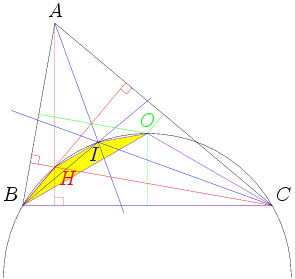

DPatrick
2011-02-09 21:24:17
BC is fixed; BC = 1. Point O is also fixed, so arc BO is fixed. So, our problem is to find the measure of angle B such that the resulting locations of H and I maximize the area of BHIO.
BC is fixed; BC = 1. Point O is also fixed, so arc BO is fixed. So, our problem is to find the measure of angle B such that the resulting locations of H and I maximize the area of BHIO.
xixianxiang
2011-02-09 21:24:32
and to maximize remaining area, H, I should be spread out evenly
and to maximize remaining area, H, I should be spread out evenly
DPatrick
2011-02-09 21:24:35
How come?
How come?
DPatrick
2011-02-09 21:24:54
A reasonable guess is that the area is maximized when the arcs BH, HI, and IO are congruent. Is this true?
A reasonable guess is that the area is maximized when the arcs BH, HI, and IO are congruent. Is this true?
GeorgiaTechMan
2011-02-09 21:25:15
yes?
yes?
PowerOfPi
2011-02-09 21:25:15
yes
yes
tan90
2011-02-09 21:25:15
yes
yes
Cortana
2011-02-09 21:25:15
yes
yes
osmosis92
2011-02-09 21:25:15
Yes
Yes
DPatrick
2011-02-09 21:25:18
How come?
How come?
DPatrick
2011-02-09 21:25:39
Let me make life a little easier by removing some of the noise from the picture:
Let me make life a little easier by removing some of the noise from the picture:
DPatrick
2011-02-09 21:25:46
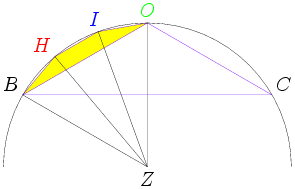

Shoelace Thm.
2011-02-09 21:26:04
The same stretching argument you used earlier
The same stretching argument you used earlier
GausssWill
2011-02-09 21:26:04
Reasoning. If they are equal, the height of the quadrilaterial will be taller
Reasoning. If they are equal, the height of the quadrilaterial will be taller
DPatrick
2011-02-09 21:26:19
Essentially, yes, it's sort of the same argument as in the previous problem.
Essentially, yes, it's sort of the same argument as in the previous problem.
DPatrick
2011-02-09 21:26:54
If I move H closer to B, the triangle BHI gets smaller (since its height shrinks) and the rest stays the same.
If I move H closer to B, the triangle BHI gets smaller (since its height shrinks) and the rest stays the same.
DPatrick
2011-02-09 21:27:06
So I want H to be where the height of BHI is maximized, and that's in the center of arc BI.
So I want H to be where the height of BHI is maximized, and that's in the center of arc BI.
DPatrick
2011-02-09 21:27:20
In the same way we want point I to be the midpoint of arc HO.
In the same way we want point I to be the midpoint of arc HO.
DPatrick
2011-02-09 21:27:29
So BH = HI = IO maximizes the yellow area.
So BH = HI = IO maximizes the yellow area.
DPatrick
2011-02-09 21:27:40
(This is a little hand-wavy but hopefully you get the idea.)
(This is a little hand-wavy but hopefully you get the idea.)
DPatrick
2011-02-09 21:27:48
Now, last step: back to the original diagram. Is it possible for H and I to divide arc BO in three equal pieces?
Now, last step: back to the original diagram. Is it possible for H and I to divide arc BO in three equal pieces?
DPatrick
2011-02-09 21:27:58


VIPMaster
2011-02-09 21:28:19
yes it is
yes it is
Cortana
2011-02-09 21:28:20
yes
yes
1228panda
2011-02-09 21:28:20
yes
yes
DPatrick
2011-02-09 21:28:32
How so, and what does <CBA end up as?
How so, and what does <CBA end up as?
DPatrick
2011-02-09 21:29:38
Recall arc BO is 60 degrees of the circle (from the top picture), so BH and HI and IO will each span 20 degrees of the circle.
Recall arc BO is 60 degrees of the circle (from the top picture), so BH and HI and IO will each span 20 degrees of the circle.
VIPMaster
2011-02-09 21:30:03
CBA becomes 80 because half of <B becomes 120/3 = 40
CBA becomes 80 because half of <B becomes 120/3 = 40
DPatrick
2011-02-09 21:30:28
Aha! CBI intercepts 80 degrees of arc of the circle (from I over to C).
Aha! CBI intercepts 80 degrees of arc of the circle (from I over to C).
DPatrick
2011-02-09 21:30:39
So <CBI = 80/2 = 40.
So <CBI = 80/2 = 40.
DPatrick
2011-02-09 21:30:47
But that's half of angle B, since BI is the bisector.
But that's half of angle B, since BI is the bisector.
DPatrick
2011-02-09 21:30:53
So <B = 80, answer (D).
So <B = 80, answer (D).
DPatrick
2011-02-09 21:31:07
This was pretty hard.
This was pretty hard.
DPatrick
2011-02-09 21:31:36
We've been going for 2 hours, but I'm willing to do one more problem.
We've been going for 2 hours, but I'm willing to do one more problem.
DPatrick
2011-02-09 21:31:52
Please vote for one of 16-20 on the 10A or 12A (and say which test).
Please vote for one of 16-20 on the 10A or 12A (and say which test).
DPatrick
2011-02-09 21:32:35
#20 on the 12A is the clear winner.
#20 on the 12A is the clear winner.
DPatrick
2011-02-09 21:32:46


DPatrick
2011-02-09 21:33:17
How can we use the fact that f(1) = 0?
How can we use the fact that f(1) = 0?
lg5293
2011-02-09 21:33:28
plug in 1 to get a+b+c=0
plug in 1 to get a+b+c=0
xixianxiang
2011-02-09 21:33:28
a+b+c=0
a+b+c=0
AlphaMath1
2011-02-09 21:33:28
a+b+c=0
a+b+c=0
yankeesrule007
2011-02-09 21:33:28
c=-(a+b)
c=-(a+b)
gh625
2011-02-09 21:33:28
a+b+c=0
a+b+c=0
rdj5933mile5
2011-02-09 21:33:28
a+b+c=0
a+b+c=0
DPatrick
2011-02-09 21:33:35
Right, plugging it in gives a+b+c = 0.
Right, plugging it in gives a+b+c = 0.
DPatrick
2011-02-09 21:33:38
So c = -(a+b)
So c = -(a+b)
DPatrick
2011-02-09 21:33:48
So the polynomial is f(x) = ax^2 + bx - (a+b).
So the polynomial is f(x) = ax^2 + bx - (a+b).
DPatrick
2011-02-09 21:34:02
That factors pretty nicely!
That factors pretty nicely!
DPatrick
2011-02-09 21:34:21
It factors as (x-1)(a(x+1) + b).
It factors as (x-1)(a(x+1) + b).
DPatrick
2011-02-09 21:34:36
In particular x-1 is a factor of f(x).
In particular x-1 is a factor of f(x).
DPatrick
2011-02-09 21:34:56
So f(7) is a multiple of 6 and f(8) is a multiple of 7.
So f(7) is a multiple of 6 and f(8) is a multiple of 7.
fractals
2011-02-09 21:35:01
so f(7)=54
so f(7)=54
girishvar12
2011-02-09 21:35:05
f(7)=54 because it has to be a multiple of 6
f(7)=54 because it has to be a multiple of 6
xxrxxhxx
2011-02-09 21:35:07
f(8) = 77
f(8) = 77
DPatrick
2011-02-09 21:35:17
Right, the only possibilities are f(7) = 54 and f(8) = 77.
Right, the only possibilities are f(7) = 54 and f(8) = 77.
DPatrick
2011-02-09 21:35:39
Plug those in to the equation of f(x) to solve for a and b. You should get a = 2 and b = -7.
Plug those in to the equation of f(x) to solve for a and b. You should get a = 2 and b = -7.
DPatrick
2011-02-09 21:35:58
Thus f(x) = 2x^2 - 7x + 5, and f(100) = 20000 - 700 + 5.
Thus f(x) = 2x^2 - 7x + 5, and f(100) = 20000 - 700 + 5.
DPatrick
2011-02-09 21:36:07
This is clearly between 15000 and 20000, so k=3 and the answer is (C).
This is clearly between 15000 and 20000, so k=3 and the answer is (C).
DPatrick
2011-02-09 21:36:32
That was quick, so I'll do #20 on the 10A which was also in high demand and is also quick. :)
That was quick, so I'll do #20 on the 10A which was also in high demand and is also quick. :)
DPatrick
2011-02-09 21:36:42


DPatrick
2011-02-09 21:37:12
How much of the circle does a chord of length r cut off if the radius is also r?
How much of the circle does a chord of length r cut off if the radius is also r?
Caelestor
2011-02-09 21:37:28
1/6
1/6
camath14
2011-02-09 21:37:28
1/6
1/6
fractals
2011-02-09 21:37:28
1/6
1/6
AlphaMath1
2011-02-09 21:37:28
1/6
1/6
Iggy Iguana
2011-02-09 21:37:28
1/6
1/6
LaTeX
2011-02-09 21:37:28
1/6 of the circumference
1/6 of the circumference
esque
2011-02-09 21:37:28
1/6th, since the angle is 60 degrees
1/6th, since the angle is 60 degrees
DPatrick
2011-02-09 21:37:36
Right: it cuts off 1/6 (or 60 degrees) of the circle.
Right: it cuts off 1/6 (or 60 degrees) of the circle.
girishvar12
2011-02-09 21:37:47
the first point can be anywhere on the circumfrence
the first point can be anywhere on the circumfrence
PowerOfPi
2011-02-09 21:37:51
WLOG, let the first point be at the top
WLOG, let the first point be at the top
DPatrick
2011-02-09 21:38:00
Right: the first point can be anywhere on the circle.
Right: the first point can be anywhere on the circle.
DPatrick
2011-02-09 21:38:17
And we just concluded that the second point must be within 1/6th of the circle away from the first point.
And we just concluded that the second point must be within 1/6th of the circle away from the first point.
xixianxiang
2011-02-09 21:38:26
then next point can be 1/6 to the right or to the left, which adds up to 1/3
then next point can be 1/6 to the right or to the left, which adds up to 1/3
DPatrick
2011-02-09 21:38:47
Right: so the second point must be on 1/3 of the circle, so the probability is 1/3. Answer (D).
Right: so the second point must be on 1/3 of the circle, so the probability is 1/3. Answer (D).
DPatrick
2011-02-09 21:39:07
OK, that's 2 hours + 10 minutes, so I'm done for the night.
OK, that's 2 hours + 10 minutes, so I'm done for the night.
DPatrick
2011-02-09 21:39:20
Many people are posting their solutions on the AMC forum and/or the wiki on our website.
Many people are posting their solutions on the AMC forum and/or the wiki on our website.
worthawholebean
2011-02-09 21:39:35
Thank you everyone for coming!
Thank you everyone for coming!
DPatrick
2011-02-09 21:39:44
You can also find the answers at amc.maa.org.
You can also find the answers at amc.maa.org.
DPatrick
2011-02-09 21:39:56
Hope you did well on the contest and enjoyed the Math Jam.
Hope you did well on the contest and enjoyed the Math Jam.
DPatrick
2011-02-09 21:40:05
And good luck on the 10B/12B if you're taking it in two weeks!
And good luck on the 10B/12B if you're taking it in two weeks!
DPatrick
2011-02-09 21:40:17
A transcript of this discussion will be available on the website shortly.
A transcript of this discussion will be available on the website shortly.
DPatrick
2011-02-09 21:40:23
Good night!
Good night!
Copyright © 2025 AoPS Incorporated. This page is copyrighted material. You can view and print this page for your own use, but you cannot share the contents of this file with others.









